Dielectric and Energy Storage Properties of Ba(1−x)CaxZryTi(1−y)O3 (BCZT): A Review
Abstract
1. Introduction
2. An Overview of Dielectric Properties
Dielectric Properties and Energy Storage
3. Dielectric Materials for High Energy-Storage Application
3.1. Lead-Based RFE Ceramics
3.2. Barium Titanate (BT)-Based Lead-Free Ceramic System
3.3. Modified BaTiO3 (From BaTiO3 to BCZT)
4. Dielectric and Energy Storage Properties of Pure BCZT
5. Synthesis Techniques Effects on Dielectric Properties of BCZT
6. Dielectric Properties of Doped BCZT
7. BCZT Thin Films for Enhancement of Dielectric Properties
7.1. BCZT for Multiferroic Composites
7.2. Future Prospects
7.3. Conclusions
Author Contributions
Funding
Acknowledgments
Conflicts of Interest
References
- Smallman, R.E.; Bishop, R.J. Modern Physical Metallurgy and Materials Engineering; Elsevier: Amsterdam, The Netherlands, 1999. [Google Scholar]
- Hao, X. A review on the dielectric materials for high energy-storage application. J. Adv. Dielectr. 2013, 3, 1330001. [Google Scholar] [CrossRef]
- Suzuki, Y.; Suzuki, T.S.; Hirao, K.; Tsuchiya, T.; Nagata, H.; Cross, J.S. Advanced Ceramic Technologies & Products; Springer Science & Business Media: Berlin, Germany, 2012. [Google Scholar]
- Peng, B.; Zhang, Q.; Li, X.; Sun, T.; Fan, H.; Ke, S.; Ye, M.; Wang, Y.; Lu, W.; Niu, H. Giant electric energy density in epitaxial lead-free thin films with coexistence of ferroelectrics and antiferroelectrics. Adv. Electron. Mater. 2015, 1, 1500052. [Google Scholar] [CrossRef]
- Fletcher, N.; Hilton, A.; Ricketts, B. Optimization of energy storage density in ceramic capacitors. J. Phys. D Appl. Phys. 1996, 29, 253. [Google Scholar] [CrossRef]
- Zhang, T.F.; Tang, X.G.; Huang, X.X.; Liu, Q.X.; Jiang, Y.P.; Zhou, Q.F. High-Temperature Dielectric Relaxation Behaviors of Relaxer-Like PbZrO3–SrTiO3 Ceramics for Energy-Storage Applications. Energy Technol. 2016, 4, 633–640. [Google Scholar] [CrossRef]
- Zhang, T.; Tang, X.; Liu, Q.; Jiang, Y.; Huang, X.; Zhou, Q. Energy-storage properties and high-temperature dielectric relaxation behaviors of relaxor ferroelectric Pb(Mg1/3Nb2/3)O3–PbTiO3 ceramics. J. Phys. D Appl. Phys. 2016, 49, 095302. [Google Scholar] [CrossRef]
- Chauhan, A.; Patel, S.; Vaish, R. Effect of Directional Mechanical Confinement on the Electrical Energy Storage Density in 68Pb(Mn1/3Nb2/3)O3-32PbTiO3 Single Crystals. Ferroelectrics 2015, 478, 40–53. [Google Scholar] [CrossRef]
- Bakshi, A.N.; Moghal, A.A.B.; Madhar, N.A.; Patel, S.; Vaish, R. Effect of Stress on Energy Conversion and Storage Characteristics of (1−xy)PIN-xPMN-yPT Single Crystals. Ferroelectr. Lett. Sect. 2015, 42, 107–114. [Google Scholar] [CrossRef]
- Ye, M.; Li, T.; Sun, Q.; Liu, Z.; Peng, B.; Huang, C.; Lin, P.; Ke, S.; Zeng, X.; Peng, X. A giant negative electrocaloric effect in Eu-doped PbZrO3 thin films. J. Mater. Chem. C 2016, 4, 3375–3378. [Google Scholar] [CrossRef]
- Peng, B.; Zhang, Q.; Li, X.; Sun, T.; Ke, S.; Ye, M.; Wang, Y.; Lu, W.; Niu, H.; Zeng, X. High dielectric tunability, electrostriction strain and electrocaloric strength at a tricritical point of tetragonal, rhombohedral and pseudocubic phases. J. Alloy. Compd. 2015, 646, 597–602. [Google Scholar] [CrossRef]
- Peng, B.; Zhang, Q.; Li, X.; Sun, T.; Fan, H.; Ke, S.; Ye, M.; Wang, Y.; Lu, W.; Niu, H. Large energy storage density and high thermal stability in a highly textured (111)-oriented Pb0.8Ba0.2ZrO3 relaxor thin film with the coexistence of antiferroelectric and ferroelectric phases. ACS Appl. Mater. Interfaces 2015, 7, 13512–13517. [Google Scholar] [CrossRef]
- Li, B.; Liu, Q.-X.; Tang, X.-G.; Zhang, T.-F.; Jiang, Y.-P.; Li, W.-H.; Luo, J. Antiferroelectric to relaxor ferroelectric phase transition in PbO modified (Pb0.97La0.02)(Zr0.95Ti0.05)O3 ceramics with a large energy-density for dielectric energy storage. RSC Adv. 2017, 7, 43327–43333. [Google Scholar] [CrossRef]
- Gao, J.; Liu, Y.; Wang, Y.; Wang, D.; Zhong, L.; Ren, X. High temperature-stability of (Pb0.9La0.1)(Zr0.65Ti0.35)O3 ceramic for energy-storage applications at finite electric field strength. Scr. Mater. 2017, 137, 114–118. [Google Scholar] [CrossRef]
- Jo, H.R.; Lynch, C.S. A high energy density relaxor antiferroelectric pulsed capacitor dielectric. J. Appl. Phys. 2016, 119, 024104. [Google Scholar] [CrossRef]
- Peng, B.; Zhang, Q.; Ke, S.; Li, T.; Niu, H.; Zeng, X.; Fan, H.; Huang, H. Large electrocaloric strength in the (100)-oriented relaxor ferroelectric Pb [(Ni1/3Nb2/3)0.6Ti0.4]O3 single crystal at near morphotropic phase boundary. Ceram. Int. 2015, 41, 9344–9349. [Google Scholar] [CrossRef]
- Peng, B.; Fan, H.; Zhang, Q. A giant electrocaloric effect in nanoscale antiferroelectric and ferroelectric phases coexisting in a relaxor Pb0.8Ba0.2ZrO3 thin film at room temperature. Adv. Funct. Mater. 2013, 23, 2987–2992. [Google Scholar] [CrossRef]
- Peddigari, M.; Palneedi, H.; Hwang, G.-T.; Ryu, J. Linear and nonlinear dielectric ceramics for high-power energy storage capacitor applications. J. Korean Ceram. Soc. 2018, 56, 1–23. [Google Scholar] [CrossRef]
- Peng, B.; Jintao, J.; Zhang, Y.; Zhao, W.; Zou, B.; Luo, N.; Zhang, Q.; Leighton, G.; Shaw, C.; Liu, L.; et al. Frequency sensitive large positive & negative electrocaloric effect in Pb0.99Nb0.02(Zr0.65Sn0.3Ti0.05)0.98O3 thin film. Ceram. Int. 2019. Accepted. [Google Scholar]
- Peng, B.; Jiang, J.; Tang, S.; Zhang, M.; Liu, L.; Zou, B.; Leighton, G.; Shaw, C.; Iou, N.; Zhang, Q.; et al. Tailoring the electrocaloric effect of Pb0.78Ba0.2La0.02ZrO3 relaxor thin film by GaN substrates. J. Mater. Chem. C 2019. Accepted. [Google Scholar]
- Acosta, M.; Novak, N.; Rojas, V.; Patel, S.; Vaish, R.; Koruza, J.; Rossetti, G., Jr.; Rödel, J. BaTiO3-based piezoelectrics: Fundamentals, current status, and perspectives. Appl. Phys. Rev. 2017, 4, 041305. [Google Scholar] [CrossRef]
- Directive, E.U. Restriction of the Use of Certain Hazardous Substances in Electrical and Electronic Equipment (RoHS). Off. J. Eur. Communities 2013, 46, 19–23. [Google Scholar]
- Directive, E.E. Waste electrical and electronic equipment (WEEE). Off. J. Eur. Union L 2002, 37, 24–38. [Google Scholar]
- Yasseri, M.; Abdizadeh, H.; Shakeri, A.; Golobostanfard, M.R. Low temperature synthesis of barium titanate powder by a modified sol-gel method. Proc. Adv. Mater. Res. 2013, 829, 727–731. [Google Scholar] [CrossRef]
- Uchino, K.; Sadanaga, E.; Hirose, T. Dependence of the crystal structure on particle size in barium titanate. J. Am. Ceram. Soc. 1989, 72, 1555–1558. [Google Scholar] [CrossRef]
- Coondoo, I.; Panwar, N.; Kholkin, A. Lead-free piezoelectrics: Current status and perspectives. J. Adv. Dielectr. 2013, 3, 1330002. [Google Scholar] [CrossRef]
- Zang, G.Z.; Wang, J.F.; Chen, H.C.; Su, W.-B.; Wang, C.M.; Qi, P.; Ming, B.Q.; Du, J.; Zheng, L.M.; Zhang, S. Perovskite (Na0.5K0.5)1−x(LiSb)xNb1−xO3 lead-free piezoceramics. Appl. Phys. Lett. 2006, 88, 212908. [Google Scholar] [CrossRef]
- Yuan, Y.; Zhang, S.; Zhou, X.; Liu, J. Phase transition and temperature dependences of electrical properties of [Bi0.5(Na1−x−yKxLiy)0.5]TiO3 ceramics. Jpn. J. Appl. Phys. 2006, 45, 831. [Google Scholar] [CrossRef]
- Yoo, J.; Hong, J.; Lee, H.; Jeong, Y.; Lee, B.; Song, H.; Kwon, J. Piezoelectric and dielectric properties of La2O3 added Bi(Na,K)TiO3–SrTiO3 ceramics for pressure sensor application. Sens. Actuators A Phys. 2006, 126, 41–47. [Google Scholar] [CrossRef]
- Lin, D.; Xiao, D.; Zhu, J.; Yu, P. Piezoelectric and ferroelectric properties of [Bi0.5(Na1−x−yKxLiy)0.5]TiO3 lead-free piezoelectric ceramics. Appl. Phys. Lett. 2006, 88, 062901. [Google Scholar] [CrossRef]
- Choy, S.; Wang, X.; Chan, H.; Choy, C. Study of compressive type accelerometer based on lead-free BNKBT piezoceramics. Appl. Phys. A 2006, 82, 715–718. [Google Scholar] [CrossRef]
- Wang, R.; Xie, R.J.; Hanada, K.; Matsusaki, K.; Bando, H.; Itoh, M. Phase diagram and enhanced piezoelectricity in the strontium titanate doped potassium–sodium niobate solid solution. Phys. Status Solidi A 2005, 202, R57–R59. [Google Scholar] [CrossRef]
- Takenaka, T.; Nagata, H. Current status and prospects of lead-free piezoelectric ceramics. J. Eur. Ceram. Soc. 2005, 25, 2693–2700. [Google Scholar] [CrossRef]
- Matsubara, M.; Yamaguchi, T.; Sakamoto, W.; Kikuta, K.; Yogo, T.; Hirano, S.i. Processing and Piezoelectric Properties of Lead-Free (K,Na)(Nb,Ta)O3 Ceramics. J. Am. Ceram. Soc. 2005, 88, 1190–1196. [Google Scholar] [CrossRef]
- Matsubara, M.; Kikuta, K.; Hirano, S. Piezoelectric properties of (K0.5Na0.5)(Nb1−xTax)O3–K5.4CuTa10O29 ceramics. J. Appl. Phys. 2005, 97, 114105. [Google Scholar] [CrossRef]
- Hollenstein, E.; Davis, M.; Damjanovic, D.; Setter, N. Piezoelectric properties of Li-and Ta-modified (K0.5Na0.5)NbO3 ceramics. Appl. Phys. Lett. 2005, 87, 182905. [Google Scholar] [CrossRef]
- Guo, Y.; Kakimoto, K.-I.; Ohsato, H. (Na0.5K0.5)NbO3–LiTaO3 lead-free piezoelectric ceramics. Mater. Lett. 2005, 59, 241–244. [Google Scholar] [CrossRef]
- Wang, X.; Tang, X.; Chan, H. Electromechanical and ferroelectric properties of (Bi1∕2Na1∕2)TiO3(Bi1∕2K1∕2)TiO3–BaTiO3 lead-free piezoelectric ceramics. Appl. Phys. Lett. 2004, 85, 91–93. [Google Scholar] [CrossRef]
- Saito, Y.; Takao, H.; Tani, T.; Nonoyama, T.; Takatori, K.; Homma, T.; Nagaya, T.; Nakamura, M. Lead-free piezoceramics. Nature 2004, 432, 84. [Google Scholar] [CrossRef]
- Hiruma, Y.; Aoyagi, R.; Nagata, H.; Takenaka, T. Piezoelectric properties of BaTiO3–(Bi1/2K1/2)TiO3 ferroelectric ceramics. Jpn. J. Appl. Phys. 2004, 43, 7556. [Google Scholar] [CrossRef]
- Takenaka, T.; Nagata, H. Present status of non-lead-based piezoelectric ceramics. Key Eng. Mater. 1999, 157, 57–64. [Google Scholar] [CrossRef]
- Takenaka, T.; Maruyama, K.-I.; Sakata, K. (Bi1/2Na1/2)TiO3-BaTiO3 system for lead-free piezoelectric ceramics. Jpn. J. Appl. Phys. 1991, 30, 2236. [Google Scholar] [CrossRef]
- Ogihara, H.; Randall, C.A.; Trolier-McKinstry, S. High-energy density capacitors utilizing 0.7BaTiO30.3BiScO3 ceramics. J. Am. Ceram. Soc. 2009, 92, 1719–1724. [Google Scholar] [CrossRef]
- Sharma, Y.; Musico, B.L.; Gao, X.; Hua, C.; May, A.F.; Herklotz, A.; Rastogi, A.; Mandrus, D.; Yan, J.; Lee, H.N.; et al. Single-crystal high entropy perovskite oxide epitaxial films. Phys. Rev. Mater. 2018, 2, 060404. [Google Scholar] [CrossRef]
- Cummins, S.; Cross, L. Electrical and optical properties of ferroelectric Bi4Ti3O12 single crystals. J. Appl. Phys. 1968, 39, 2268–2274. [Google Scholar] [CrossRef]
- Liu, W.; Ren, X. Large piezoelectric effect in Pb-free ceramics. Phys. Rev. Lett. 2009, 103, 257602. [Google Scholar] [CrossRef]
- Zhang, L.; Liu, W.; Chen, W.; Ren, X.; Sun, J.; Gurdal, E.A.; Ural, S.O.; Uchino, K. Mn dopant on the “domain stabilization” effect of aged BaTiO3 and PbTiO3-based piezoelectrics. Appl. Phys. Lett. 2012, 101, 242903. [Google Scholar] [CrossRef]
- Nahm, S. Lead-Free Piezoelectrics; Springer: New York, NY, USA, 2012. [Google Scholar]
- Deshpande, V.K.; Rahangdale, V.U. Study of PbTiO 3-based glass ceramics containing SiO2. ISRN Ceram. 2012, 2012, 1–5. [Google Scholar] [CrossRef]
- Yang, Y.; Guo, J.; Ma, W.; Zhao, H.; Ma, M.; Wu, J.; Chi, M. Effects of V2O5 doping on the structure and electrical properties of BCZT lead-free piezoelectric ceramics. J. Mater. Sci. Mater. Electron. 2019, 30, 2854–2863. [Google Scholar] [CrossRef]
- Chavan, S.; Chavan, S.; Mane, S.; Joshi, P.; Salunkhe, D. Dielectric and magnetodielectric properties of LSMO-BCZT composites. J. Mater. Sci. Mater. Electron. 2016, 27, 1254–1260. [Google Scholar] [CrossRef]
- Zhang, Y.; Sun, H.; Chen, W.; Li, Y. Modification of the structure and electrical properties of Ba0.95Ca0.05Zr0.1Ti0.9O3 ceramics by the doping of Mn ions. J. Mater. Sci. Mater. Electron. 2015, 26, 10034–10043. [Google Scholar] [CrossRef]
- Cox, D.; Noheda, B.; Shirane, G.; Uesu, Y.; Fujishiro, K.; Yamada, Y. Universal phase diagram for high-piezoelectric perovskite systems. Appl. Phys. Lett. 2001, 79, 400–402. [Google Scholar] [CrossRef]
- Luo, B.; Wang, X.; Wang, Y.; Li, L. Fabrication, characterization, properties and theoretical analysis of ceramic/PVDF composite flexible films with high dielectric constant and low dielectric loss. J. Mater. Chem. A 2014, 2, 510–519. [Google Scholar] [CrossRef]
- Hanani, Z.; Mezzane, D.; Amjoud, M.; Fourcade, S.; Razumnaya, A.G.; Luk’Yanchuk, I.A.; Gouné, M. Enhancement of dielectric properties of lead-free BCZT ferroelectric ceramics by grain size engineering. Superlattices Microstruct. 2019, 127, 109–117. [Google Scholar] [CrossRef]
- Wu, J.; Xiao, D.; Wu, B.; Wu, W.; Zhu, J.; Yang, Z.; Wang, J. Sintering temperature-induced electrical properties of (Ba0.90Ca0.10)(Ti0.85Zr0.15)O3 lead-free ceramics. Mater. Res. Bull. 2012, 47, 1281–1284. [Google Scholar] [CrossRef]
- Tian, Y.; Wei, L.; Chao, X.; Liu, Z.; Yang, Z. Phase Transition Behavior and Large Piezoelectricity Near the Morphotropic Phase Boundary of Lead-Free (Ba0.85Ca0.15)(Zr0.1Ti0.9)O3 Ceramics. J. Am. Ceram. Soc. 2013, 96, 496–502. [Google Scholar]
- Zhan, D.; Xu, Q.; Huang, D.-P.; Liu, H.-X.; Chen, W.; Zhang, F. Dielectric nonlinearity and electric breakdown behaviors of Ba0.95Ca0.05Zr0.3Ti0.7O3 ceramics for energy storage utilizations. J. Alloy. Compd. 2016, 682, 594–600. [Google Scholar] [CrossRef]
- Tang, X.-G.; Chan, H.L.-W. Effect of grain size on the electrical properties of (Ba,Ca)(Zr,Ti)O3 relaxor ferroelectric ceramics. J. Appl. Phys. 2005, 97, 034109. [Google Scholar] [CrossRef]
- Li, W.; Hao, J.; Zeng, H.; Zhai, J. Dielectric and piezoelectric properties of the Ba0.92Ca0.08Ti0.95Zr0.05O3 thin films grown on different substrate. Curr. Appl. Phys. 2013, 13, 1205–1208. [Google Scholar] [CrossRef]
- Sadhu, S.P.P.; Siddabattuni, S.; Varma, K. Enhanced dielectric properties and energy storage density of surface engineered BCZT/PVDF-HFP nanodielectrics. J. Mater. Sci. Mater. Electron. 2018, 29, 6174–6182. [Google Scholar] [CrossRef]
- He, S.; Peng, B.; Leighton, G.J.; Shaw, C.; Wang, N.; Sun, W.; Liu, L.; Zhang, Q. High-performance La-doped BCZT thin film capacitors on LaNiO3/Pt composite bottom electrodes with ultra-high efficiency and high thermal stability. Ceram. Int. 2019, 45, 11749–11755. [Google Scholar] [CrossRef]
- Ji, X.; Wang, C.; Li, S.; Zhang, S.; Tu, R.; Shen, Q.; Shi, J.; Zhang, L. Structural and electrical properties of BCZT ceramics synthesized by sol–gel process. J. Mater. Sci. Mater. Electron. 2018, 29, 7592–7599. [Google Scholar] [CrossRef]
- Wang, Z.; Wang, J.; Chao, X.; Wei, L.; Yang, B.; Wang, D.; Yang, Z. Synthesis, structure, dielectric, piezoelectric, and energy storage performance of (Ba0.85Ca0.15)(Ti0.9Zr0.1)O3 ceramics prepared by different methods. J. Mater. Sci. Mater. Electron. 2016, 27, 5047–5058. [Google Scholar] [CrossRef]
- Yan, X.; Gao, F.; Peng, B.; Liu, Z. Grain growth, densification and electrical properties of lead-free piezoelectric ceramics from nanocrystalline (Ba0.85Ca0.15)(Ti0.90Zr0.10)O3 powder by sol–gel technique. J. Mater. Sci. Mater. Electron. 2014, 25, 2220–2226. [Google Scholar] [CrossRef]
- Cui, Y.; Liu, X.; Jiang, M.; Hu, Y.; Su, Q.; Wang, H. Lead-free (Ba0.7Ca0.3)TiO3-Ba(Zr0.2Ti0.8)O3-xwt%CuO ceramics with high piezoelectric coefficient by low-temperature sintering. J. Mater. Sci. Mater. Electron. 2012, 23, 1342–1345. [Google Scholar] [CrossRef]
- Li, A.; Wang, Y.; Yang, L.; Yang, P.; Wang, G.; Chen, J.; Wang, R. Ferroelectric relaxor behavior and dielectric properties of La/Y co-doped (Ba0.9Ca0.1)(Zr0.2Ti0.8)O3 ceramics. J. Mater. Sci. Mater. Electron. 2016, 27, 6150–6155. [Google Scholar] [CrossRef]
- Li, Q.; Ma, W.; Ma, J.; Meng, X.; Niu, B. High piezoelectric properties of Sm2O3 doped Ba0·85Ca0·15Ti0· 90Zr0·10O3 ceramics. Mater. Technol. 2016, 31, 18–23. [Google Scholar] [CrossRef]
- Hanani, Z.; Mezzane, D.; Amjoud, M.; Razumnaya, A.G.; Fourcade, S.; Gagou, Y.; Hoummada, K.; El Marssi, M.; Gouné, M. Phase transitions, energy storage performances and electrocaloric effect of the lead-free Ba0.85Ca0.15Zr0.10Ti0.90O3 ceramic relaxor. J. Mater. Sci. Mater. Electron. 2019, 1–9. [Google Scholar] [CrossRef]
- Radoszewska, D.; Goryczka, T.; Adamczyk, M.; Wodecka-Duś, B.; Bochenek, D.; Kozielski, L. Influence of Sr2+ dopant on microstructure and electric properties of (Ba0.85Ca0.15)(Zr0.1Ti0.9)O3 (BCZT) ceramics. Arch. Met. Mater. 2018, 63, 1295–1302. [Google Scholar]
- Jaimeewong, P.; Sittinon, S.; Buntham, S.; Bomlai, P.; Namsar, O.; Pojprapai, S.; Watcharapasorn, A. Ferroelectric, Piezoelectric and Dielectric Behaviors of CoO-and Fe2O3-Doped BCZT Ceramics. Phys. Status Solidi A 2018, 215, 1701023. [Google Scholar] [CrossRef]
- Puli, V.S.; Pradhan, D.K.; Riggs, B.C.; Chrisey, D.B.; Katiyar, R.S. Structure, ferroelectric, dielectric and energy storage studies of Ba0.70Ca0.30TiO3, Ba(Zr0.20Ti0.80)O3 ceramic capacitors. Integr. Ferroelectr. 2014, 157, 139–146. [Google Scholar] [CrossRef]
- Yan, X.; Peng, B. Microstructure and electrical properties of (Ba0.85Ca0.15)(Zr0.10Ti0.90)O3 lead-free piezoelectric ceramics prepared by spark plasma sintering. J. Mater. Sci. Mater. Electron. 2015, 26, 9649–9653. [Google Scholar] [CrossRef]
- Herrera-Pérez, G.; Morales, D.; Paraguay-Delgado, F.; Borja-Urby, R.; Reyes-Rojas, A.; Fuentes-Cobas, L. Structural analysis, optical and dielectric function of [Ba0.9Ca0.1](Ti0.9Zr0.1)O3 nanocrystals. J. Appl. Phys. 2016, 120, 094303. [Google Scholar]
- Liu, W.; Cheng, L.; Li, S. Prospective of (BaCa)(ZrTi)O3 Lead-free Piezoelectric Ceramics. Crystals 2019, 9, 179. [Google Scholar] [CrossRef]
- Chao, X.; Wang, J.; Wei, L.; Gou, R.; Yang, Z. Electrical properties and low temperature sintering of BiAlO doped (BaCa)(ZrTi)O lead-free piezoelectric ceramics. J. Mater. Sci. Mater. Electron. 2015, 26, 7331–7340. [Google Scholar] [CrossRef]
- Shafee, E.E.; Behery, S. Preparation, characterization and properties of novel 0–3 ferroelectric composites of Ba0.95Ca0.05Ti0.8Zr0.2O3–poly (vinylidene fluoride-trifluoroethylene). Mater. Chem. Phys. 2012, 132, 740–746. [Google Scholar] [CrossRef]
- Ma, J.; Liu, X.; Jiang, M.; Yang, H.; Chen, G.; Liu, X.; Qin, L.; Luo, C. Dielectric, ferroelectric, and piezoelectric properties of Sb2O3-modified (Ba0.85Ca0.15)(Zr0.1Ti0.9)O3 lead-free ceramics. J. Mater. Sci. Mater. Electron. 2014, 25, 992. [Google Scholar] [CrossRef]
- Wu, J.; Xiao, D.; Wu, W.; Chen, Q.; Zhu, J.; Yang, Z.; Wang, J. Role of room-temperature phase transition in the electrical properties of (Ba,Ca)(Ti,Zr)O3 ceramics. Scr. Mater. 2011, 65, 771–774. [Google Scholar] [CrossRef]
- Parjansri, P.; Intatha, U.; Eitssayeam, S. Dielectric, ferroelectric and piezoelectric properties of Nb5+ doped BCZT ceramics. Mater. Res. Bull. 2015, 65, 61–67. [Google Scholar] [CrossRef]
- Yong, P.; Shihua, D.; Wenju, N.; Qin, X.; Xiaoliang, W. Dielectric Properties and Relaxor Behavior of Nd Doping BCZT Ceramics. Ferroelectrics 2013, 450, 21–27. [Google Scholar] [CrossRef]
- Muralt, P. PZT thin films for microsensors and actuators: Where do we stand? IEEE Trans. Ultrason. Ferroelectr. Freq. Control 2000, 47, 903–915. [Google Scholar] [CrossRef]
- Muralt, P. Ferroelectric thin films for micro-sensors and actuators: A review. J. Micromech. Microeng. 2000, 10, 136. [Google Scholar] [CrossRef]
- Feldman, C. Formation of thin films of BaTiO3 by evaporation. Rev. Sci. Instrum. 1955, 26, 463–466. [Google Scholar] [CrossRef]
- Wu, J. Advances in Lead-free Piezoelectric Materials; Springer Singapore: Singapore, 2018. [Google Scholar]
- Yang, S.; Xu, J.; Gao, B.; Wang, L.; Chen, J.; Chen, X. Orientation-dependent phase transition and dielectric properties of Ba0.85Ca0.15Ti0.9Zr0.1O3 thin films. J. Mater. Sci. Mater. Electron. 2013, 24, 658–661. [Google Scholar] [CrossRef]
- Gao, L.; Zhai, J.; Yao, X. Study of dielectric characteristics of graded Ba1−xCaxZr0.05Ti0.95O3 thin films grown by a sol-gel process. J. Sol Gel Sci. Technol. 2008, 45, 51–55. [Google Scholar] [CrossRef]
- Reynolds, G.J.; Kratzer, M.; Dubs, M.; Felzer, H.; Mamazza, R. Electrical properties of thin-film capacitors fabricated using high temperature sputtered modified barium titanate. Materials 2012, 5, 644–660. [Google Scholar] [CrossRef]
- Silva, J.P.; Silva, J.M.; Oliveira, M.J.; Weingärtner, T.; Sekhar, K.C.; Pereira, M.; Gomes, M.J. High-Performance Ferroelectric–Dielectric Multilayered Thin Films for Energy Storage Capacitors. Adv. Funct. Mater. 2019, 29, 1807196. [Google Scholar] [CrossRef]
- Mimura, K.-I.; Naka, T.; Shimura, T.; Sakamoto, W.; Yogo, T. Synthesis and dielectric properties of (Ba,Ca)(Zr,Ti)O3 thin films using metal-organic precursor solutions. Thin Solid Films 2008, 516, 8408–8413. [Google Scholar] [CrossRef]
- Jiang, L.; Tang, X.; Li, Q.; Chan, H. Dielectric properties of (Ba,Ca)(Zr,Ti)O3/CaRuO3 heterostructure thin films prepared by pulsed laser deposition. Vacuum 2009, 83, 1018–1021. [Google Scholar] [CrossRef]
- Daumont, C.J.; Simon, Q.; Le Mouellic, E.; Payan, S.; Gardes, P.; Poveda, P.; Negulescu, B.; Maglione, M.; Wolfman, J. Tunability, dielectric, and piezoelectric properties of Ba(1−x)CaxTi(1−y)ZryO3 ferroelectric thin films. J. Appl. Phys. 2016, 119, 094107. [Google Scholar] [CrossRef]
- Shi, M.; Zhong, J.; Zuo, R.; Xu, Y.; Wang, L.; Su, H.; Gu, C. Effect of annealing processes on the structural and electrical properties of the lead-free thin films of (Ba0.9Ca0.1)(Ti0.9Zr0.1)O3. J. Alloy. Compd. 2013, 562, 116–122. [Google Scholar] [CrossRef]
- Ion, V.; Craciun, F.; Scarisoreanu, N.D.; Moldovan, A.; Andrei, A.; Birjega, R.; Ghica, C.; Di Pietrantonio, F.; Cannata, D.; Benetti, M. Impact of thickness variation on structural, dielectric and piezoelectric properties of (Ba,Ca)(Ti,Zr)O3 epitaxial thin films. Sci. Rep. 2018, 8, 2056. [Google Scholar] [CrossRef]
- Kalkur, T.; Yi, W.-C.; Philofsky, E.; Kammerdiner, L. Dielectric properties and tunability of Mg-doped Ba0.96Ca0.04Ti0.84Zr0.16O3 thin films on Pt/MgO fabricated by metal organic decomposition method. Mater. Lett. 2003, 57, 4147–4150. [Google Scholar] [CrossRef]
- Chen, Q.; Shen, Y.; Zhang, S.; Zhang, Q. Polymer-based dielectrics with high energy storage density. Annu. Rev. Mater. Res. 2015, 45, 433–458. [Google Scholar] [CrossRef]
- Puli, V.S.; Pradhan, D.K.; Adireddy, S.; Martínez, R.; Silwal, P.; Scott, J.; Ramana, C.; Chrisey, D.B.; Katiyar, R.S. Nanoscale polarisation switching and leakage currents in (Ba0.955Ca0.045)(Zr0.17Ti0.83)O3 epitaxial thin films. J. Phys. D Appl. Phys. 2015, 48, 355502. [Google Scholar] [CrossRef]
- Lu, H.; Lin, J.; Yang, W.; Liu, L. Improved dielectric strength and loss tangent by interface modification in PI@ BCZT/PVDF nano-composite films with high permittivity. J. Mater. Sci. Mater. Electron. 2017, 28, 13360–13370. [Google Scholar] [CrossRef]
- Dai, Q.; Wu, D.; Guo, K.; Zhang, J.; Zhang, M.; Cui, R.; Deng, C. Ferroelectric, dielectric, ferromagnetic and magnetoelectric properties of the multiferroic heteroepitaxial NiFe2O4/Ba0.85Ca0.15Ti0.9Zr0.1O3 composite thin films deposited via PLD. J. Mater. Sci. Mater. Electron. 2018, 29, 17333–17340. [Google Scholar] [CrossRef]
- Reyes-Montero, A.; Pardo, L.; López-Juárez, R.; González, A.M.; Cruz, M.; Villafuerte-Castrejón, M. Lead-free Ba0.9Ca0.1Ti0.9Zr0.1O3 piezoelectric ceramics processed below 1300 °C. J. Alloy. Compd. 2014, 584, 28–33. [Google Scholar] [CrossRef]
- Yu, Z.; Ang, C.; Guo, R.; Bhalla, A. Piezoelectric and strain properties of Ba(Ti1−xZrx)O3 ceramics. J. Appl. Phys. 2002, 92, 1489–1493. [Google Scholar] [CrossRef]
- Sun, Z.; Pu, Y.; Dong, Z.; Hu, Y.; Liu, X.; Wang, P.; Ge, M. Dielectric and piezoelectric properties and PTC behavior of Ba0.9Ca0.1Ti0.9Zr0.1O3–xLa ceramics prepared by hydrothermal method. Mater. Lett. 2014, 118, 1–4. [Google Scholar] [CrossRef]
- Palneedi, H.; Annapureddy, V.; Priya, S.; Ryu, J. Status and Perspectives of Multiferroic Magnetoelectric Composite Materials and Applications. Actuators 2016, 5, 9. [Google Scholar] [CrossRef]
- Vopson, M.M. Fundamentals of Multiferroic Materials and Their Possible Applications. Crit. Rev. Solid State Mater. Sci. 2015, 40, 223–250. [Google Scholar] [CrossRef]
- Ramesh, R.; Spaldin, N.A. Multiferroics: Progress and prospects in thin films. Nat. Mater. 2007, 6, 21. [Google Scholar] [CrossRef] [PubMed]
- Buurma, A.J.C.; Blake, G.R.; Palstra, T.T.M.; Adem, U. Multiferroic Materials: Physics and Properties. In Reference Module in Materials Science and Materials Engineering; Elsevier: Amsterdam, The Netherlands, 2016. [Google Scholar] [CrossRef]
- Bichurin, M.; Petrov, V.; Zakharov, A.; Kovalenko, D.; Yang, S.C.; Maurya, D.; Bedekar, V.; Priya, S. Magnetoelectric Interactions in Lead-Based and Lead-Free Composites. Materials 2011, 4, 651–702. [Google Scholar] [CrossRef] [PubMed]
- Phuoc, N.N.; Ong, C.K. Electrical tuning of microwave properties via strain-mediated magnetoelectric coupling in multiferroic composites. Appl. Phys. A 2018, 124, 213. [Google Scholar] [CrossRef]
- Pradhan, L.K.; Pandey, R.; Kumar, R.; Kar, M. Lattice strain induced multiferroicity in PZT-CFO particulate composite. J. Appl. Phys. 2018, 123, 074101. [Google Scholar] [CrossRef]
- Selvi, M.M.; Manimuthu, P.; Kumar, K.S.; Venkateswaran, C. Magnetodielectric properties of CoFe2O4–BaTiO3 core–shell nanocomposite. J. Magn. Magn. Mater. 2014, 369, 155–161. [Google Scholar] [CrossRef]
- Murtaza, T.; Ali, J.; Khan, M.S. Preparation and study of (1−x)CuFe2O4–xBaTiO3 (x = 0, 0.1 and 1) composite multiferroics. Indian J. Phys. 2018, 92, 835–840. [Google Scholar] [CrossRef]
- Nanda, D.; Kumar, P.; Samanta, B.; Sahu, R.; Singh, A. Structural, Dielectric, Ferroelectric and Magnetic Properties of (BNT-BT)-NCZF Composites Synthesized by a Microwave-Assisted Solid-State Reaction Route. J. Electron. Mater. 2019, 48, 5039–5047. [Google Scholar] [CrossRef]
- Pahuja, P.; Tandon, R.P. Microstructural, dielectric and magnetic properties of multiferroic composite system barium strontium titanate—Nickel cobalt ferrite. AIP Conf. Proc. 2015, 1661, 060004. [Google Scholar] [CrossRef]
- Chen, X.Q.; Xue, Y.; Lu, Z.W.; Xiao, J.; Yao, J.; Kang, Z.W.; Su, P.; Yang, F.J.; Zeng, X.B.; Sun, H.Z. Magnetodielectric properties of Bi4NdTi3Fe0.7Co0.3O15 multiferroic system. J. Alloy. Compd. 2015, 622, 288–291. [Google Scholar] [CrossRef]
- Islam, R.A.; Priya, S. Magnetoelectric properties of the lead–free cofired BaTiO3–(Ni0.8Zn0.2)Fe2O4 bilayer composite. Appl. Phys. Lett. 2006, 89, 152911. [Google Scholar] [CrossRef]
- Bhasin, T.; Agarwal, A.; Sanghi, S.; Yadav, M.; Tuteja, M.; Singh, J.; Rani, S. Structural, dielectric and magnetic properties of ZnFe2O4-Na0.5Bi0.5TiO3 multiferroic composites. AIP Conf. Proc. 2018, 1942, 130006. [Google Scholar] [CrossRef]
- Babu, S.N.; Srinivas, K.; Bhimasankaram, T. Studies on lead-free multiferroic magnetoelectric composites. J. Magn. Magn. Mater. 2009, 321, 3764–3770. [Google Scholar] [CrossRef]
- Ullah, A.; Gul, H.B.; Ullah, A.; Sheeraz, M.; Bae, J.-S.; Jo, W.; Ahn, C.W.; Kim, I.W.; Kim, T.H. Giant room-temperature electrostrictive coefficients in lead-free relaxor ferroelectric ceramics by compositional tuning. APL Mater. 2018, 6, 016104. [Google Scholar] [CrossRef]
- Negi, N.S.; Kumar, R.; Sharma, H.; Shah, J.; Kotnala, R.K. Structural, multiferroic, dielectric and magnetoelectric properties of (1−x)Ba0.85Ca0.15Ti0.90Zr0.10O3-(x)CoFe2O4 lead-free composites. J. Magn. Magn. Mater. 2018, 456, 292–299. [Google Scholar] [CrossRef]
- Sowmya, N.S.; J, P.P.; Das, D.; Reddy, K.V.G.; Srinivas, A. Investigation of magneto-electric properties of BCZT-NFO particulate composite. AIP Conf. Proc. 2016, 1728, 020528. [Google Scholar] [CrossRef]
- Li, S.B.; Wang, C.B.; Shen, Q.; Zhang, L.M. Multiferroic properties of (1−x)BCZT-xLCMO laminated composites. Ceram. Int. 2018, 44, 231–235. [Google Scholar] [CrossRef]
- Li, S.; Wang, C.; Shen, Q.; Zhang, L. Characterization of a BCZT/LCMO/BCZT laminated composite fabricated by plasma-activated sintering. J. Appl. Phys. 2019, 125, 074101. [Google Scholar] [CrossRef]
- Paul Praveen, J.; Reddy, M.V.; Kolte, J.; Dinesh Kumar, S.; Subramanian, V.; Das, D. Synthesis, characterization, and magneto-electric properties of (1−x)BCZT-xCFO ceramic particulate composites. Int. J. Appl. Ceram. Technol. 2017, 14, 200–210. [Google Scholar] [CrossRef]
- Yan, J.-M.; Gao, G.-Y.; Liu, Y.-K.; Wang, F.-F.; Zheng, R.-K. Electric-field control of electronic transport properties and enhanced magnetoresistance in La0.7Sr0.3MnO3/0.5BaZr0.2Ti0.8O3-0.5Ba0.7Ca0.3TiO3 lead-free multiferroic structures. J. Appl. Phys. 2017, 122, 134102. [Google Scholar] [CrossRef]
- Mamun, M.A.; Haque, A.; Pelton, A.; Paul, B.; Ghosh, K. Structural, Electronic, and Magnetic Analysis and Device Characterization of Ferroelectric–Ferromagnetic Heterostructure (BZT–BCT/LSMO/LAO) Devices for Multiferroic Applications. IEEE Trans. Magn. 2018, 54, 1–8. [Google Scholar] [CrossRef]
- Naveed-Ul-Haq, M.; Shvartsman, V.V.; Salamon, S.; Wende, H.; Trivedi, H.; Mumtaz, A.; Lupascu, D.C. A new (Ba,Ca)(Ti,Zr)O3 based multiferroic composite with large magnetoelectric effect. Sci. Rep. 2016, 6, 32164. [Google Scholar] [CrossRef] [PubMed]
- Mane, S.; Tirmali, P.; Kadam, S.; Tarale, A.; Kolekar, C.; Kulkarni, S. Dielectric, magnetic, and magnetodielectric properties of x[Co0.9Ni0.1Fe2O4]-(1−x)[0.5(Ba0.7Ca0.3)TiO3)-0.5Ba(Zr0.2Ti0.8)O3] multiferroic composites. J. Chin. Adv. Mater. Soc. 2016, 4, 269–284. [Google Scholar] [CrossRef]
- Mane, S.S.; Tarale, A.N.; Chavan, S.G.; Reddy, V.R.; Joshi, P.B.; Salunkhe, D.J. Magnetoelectric and magnetodielectric properties of LSMO–(BCT–BZT) composites. Indian J. Phys. 2016, 90, 519–528. [Google Scholar] [CrossRef]
- Jarupoom, P.; Jaita, P.; Sanjoom, R.; Randorn, C.; Rujijanagul, G. High magnetic and ferroelectric properties of BZT-LSM multiferroic composites at room temperature. Ceram. Int. 2018, 44, 8768–8776. [Google Scholar] [CrossRef]
- Ramam, K.; Mouli, K.C.; Fornerod, M.J.; Rebolledo, A.E.S.; Yellapragada, A. Core Shell Structured Multiferroic Nanocomposites for Smart Energy Harvesting: Electric Powering for Portable Electronic Devices. Int. Rev. Appl. Eng. Res. 2014, 4, 57–64. [Google Scholar]
- Singh, A.; Shamim, K.; Sharma, S.; Rai, R.; Kumari, P. Enhanced electrical and magnetic properties in BZT/NFO multiferroic composites derived by MARH. J. Mater. Sci. Mater. Electron. 2018, 29, 18221–18230. [Google Scholar] [CrossRef]
- Ping, W.; Liu, W.; Li, S. Enhanced energy storage property in glass-added Ba(Zr0.2Ti0.8)O3-0.15(Ba0.7Ca0.3)TiO3 ceramics and the charge relaxation. Ceram. Int. 2019, 45, 11388–11394. [Google Scholar] [CrossRef]
- Xu, M.; Peng, B.; Zhu, J.; Liu, L.; Sun, W.; Leighton, G.J.; Shaw, C.; Luo, N.; Zhang, Q. Enhanced energy storage performance of (1−x)(BCT-BMT)-xBFO lead-free relaxor ferroelectric ceramics in a broad temperature range. J. Alloy. Compd. 2019, 789, 303–312. [Google Scholar] [CrossRef]
- Peng, B.; Zhang, Q.; Gang, B.; Leighton, G.J.; Shaw, C.; Milne, S.J.; Zou, B.; Sun, W.; Huang, H.; Wang, Z. Phase-transition induced giant negative electrocaloric effect in a lead-free relaxor ferroelectric thin film. Energy Env. Sci. 2019, 12, 1708–1717. [Google Scholar] [CrossRef]
- Zhang, S.-T.; Kounga, A.B.; Aulbach, E.; Ehrenberg, H.; Rödel, J. Giant strain in lead-free piezoceramics Bi0.5Na0.5TiO3–BaTiO3–K0.5Na0.5NbO3 system. Appl. Phys. Lett. 2007, 91, 112906. [Google Scholar] [CrossRef]
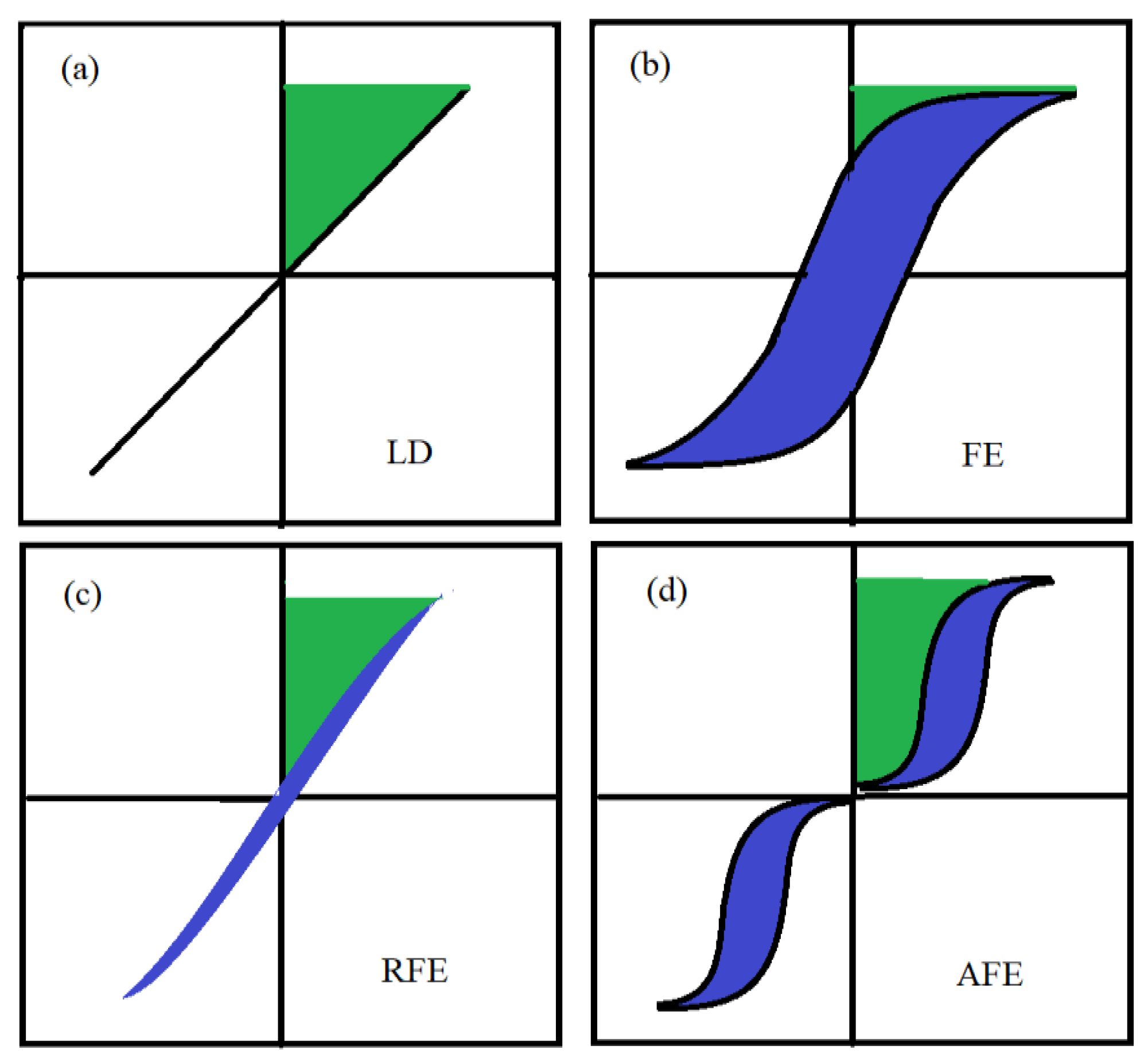
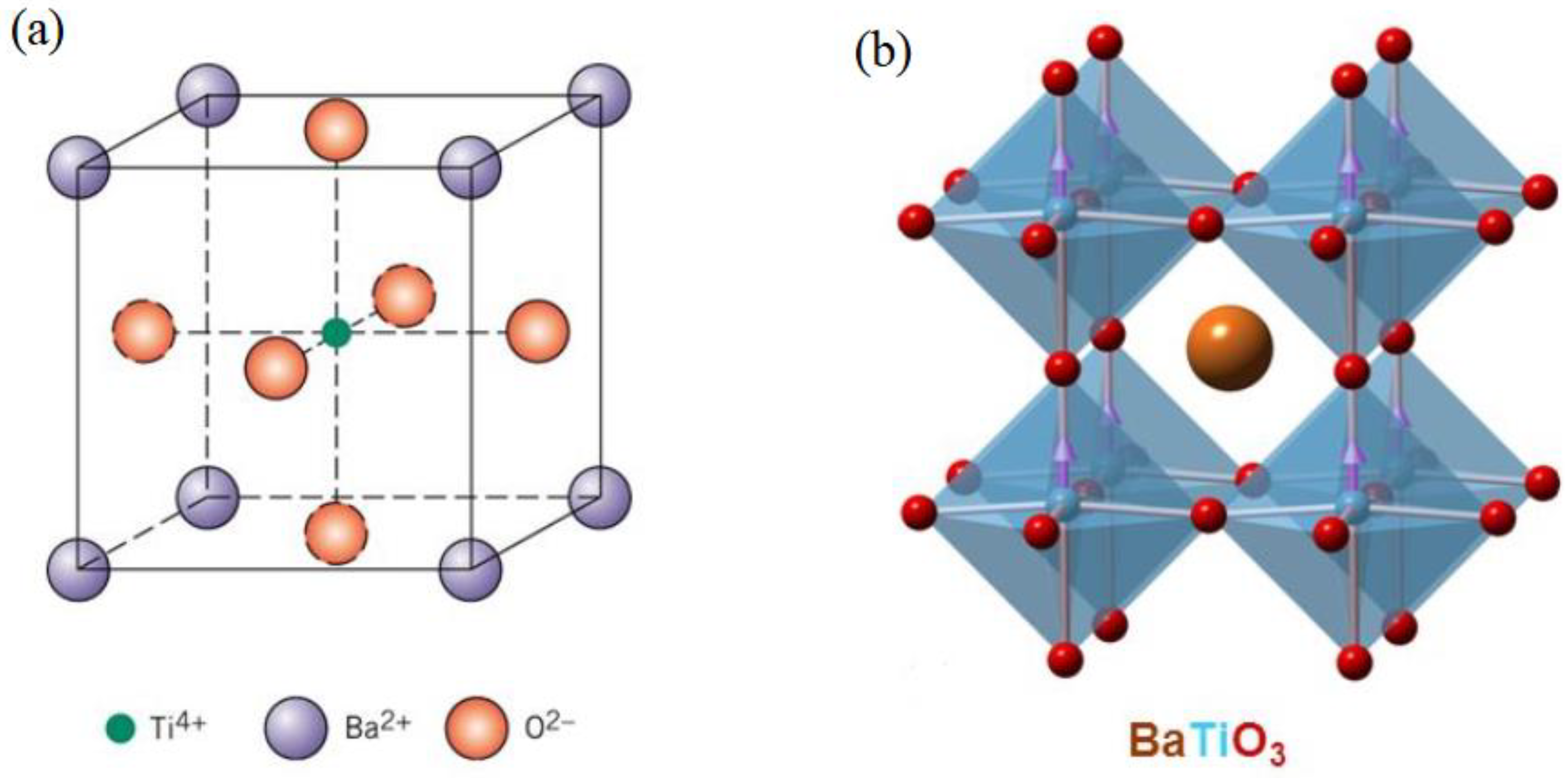
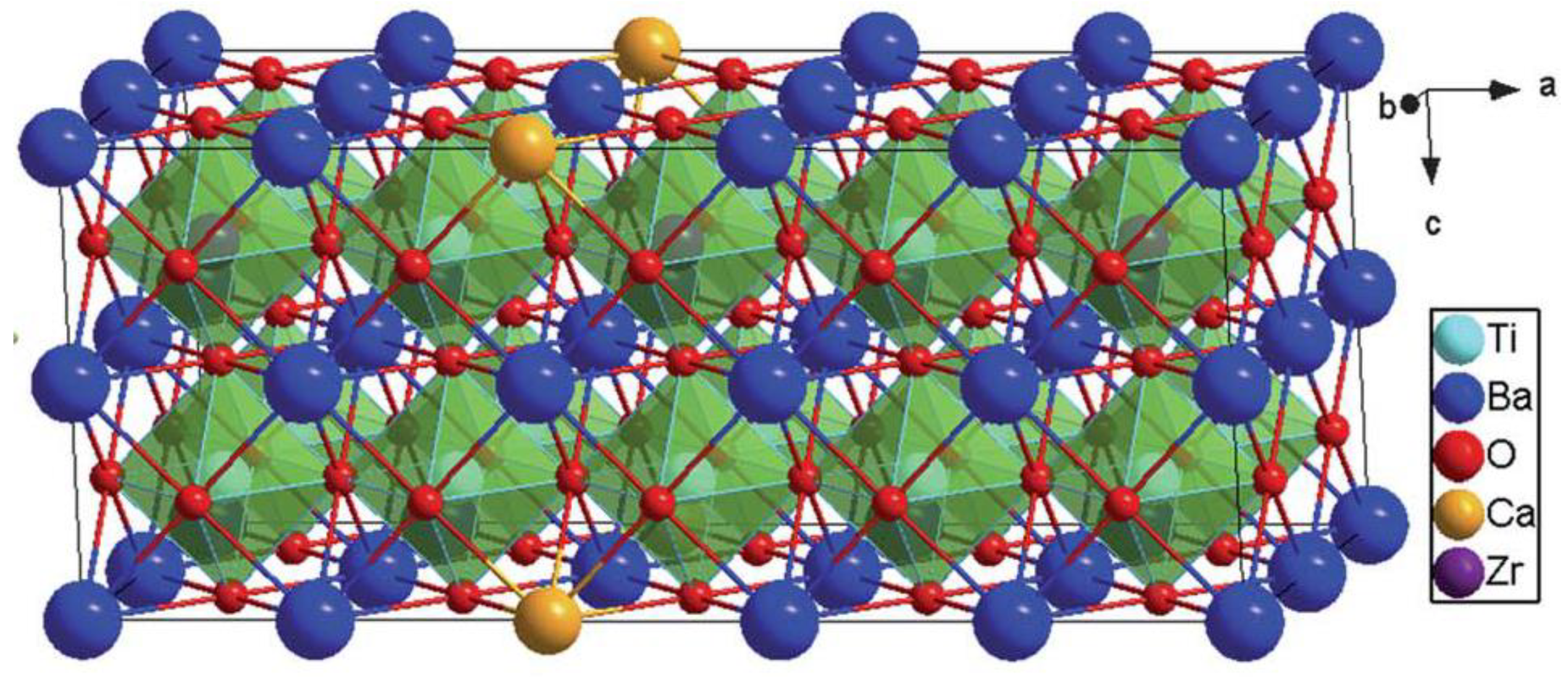
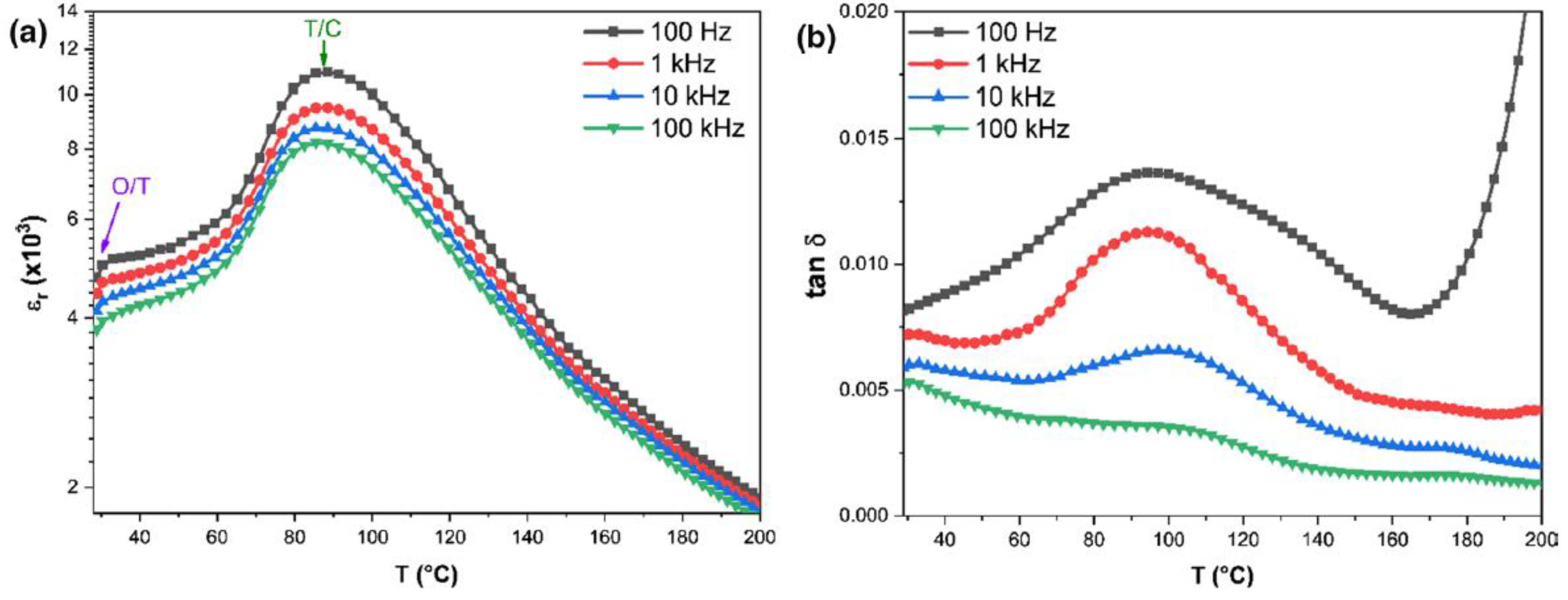
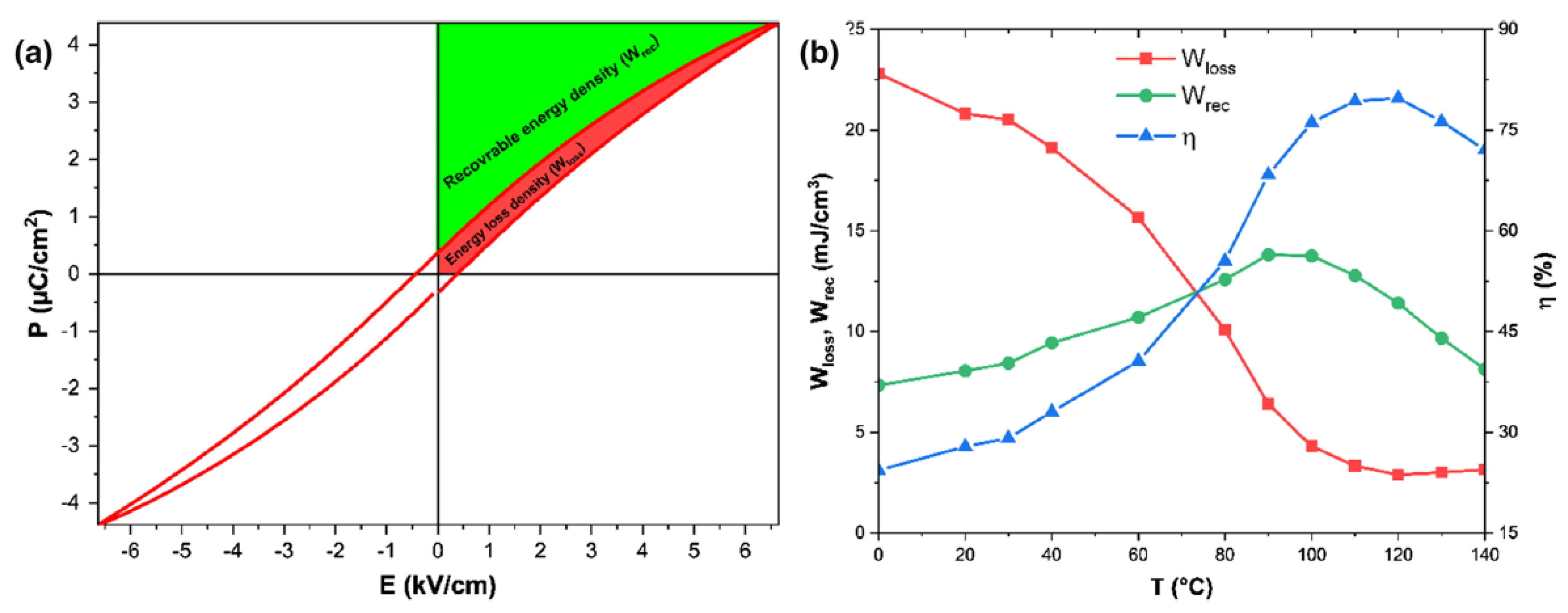

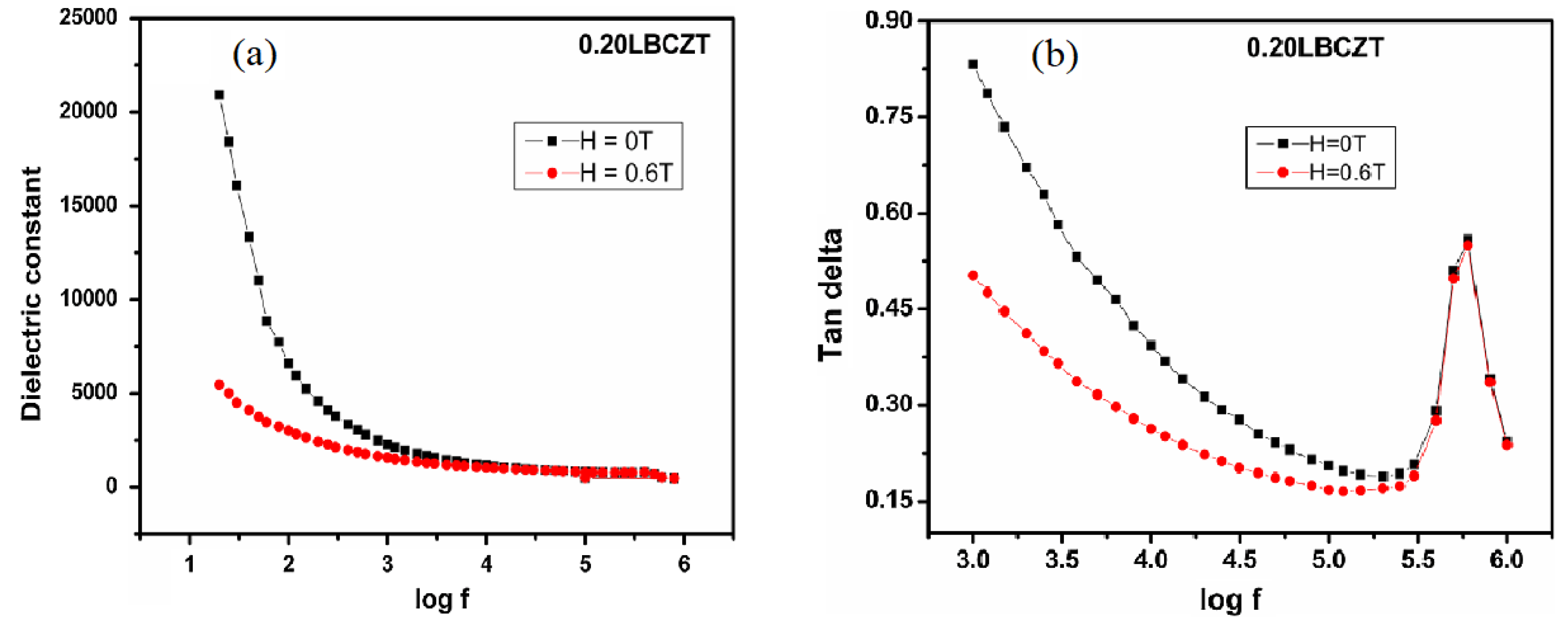

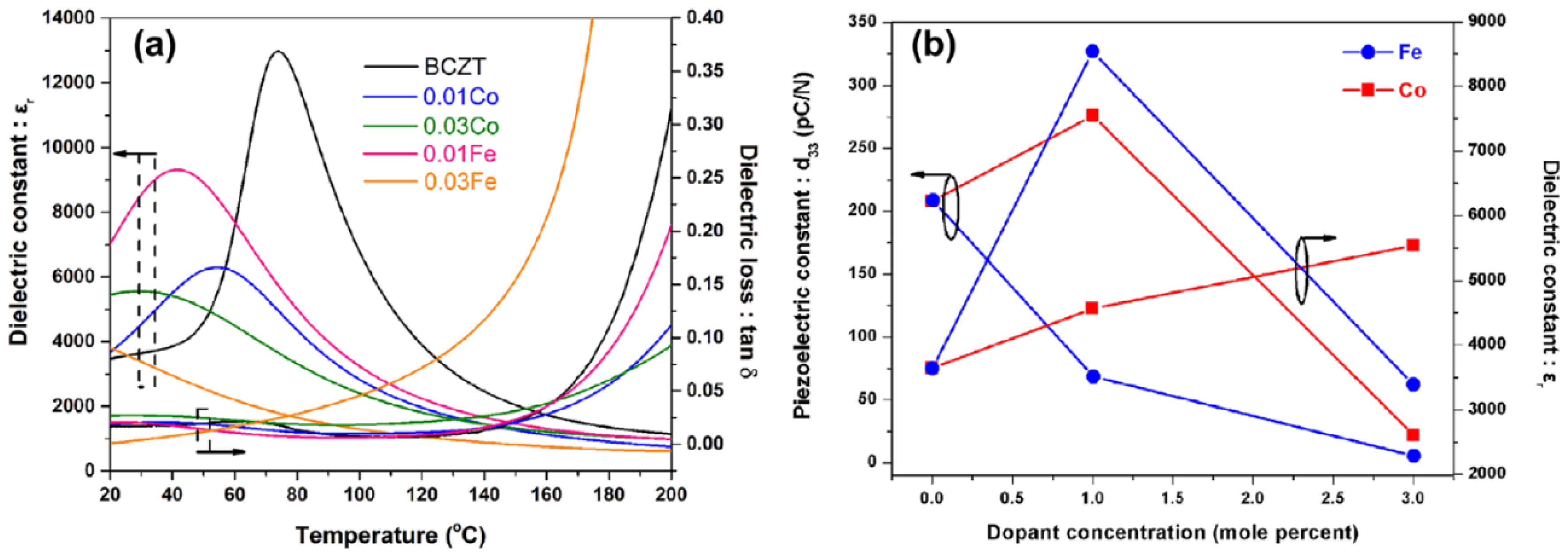
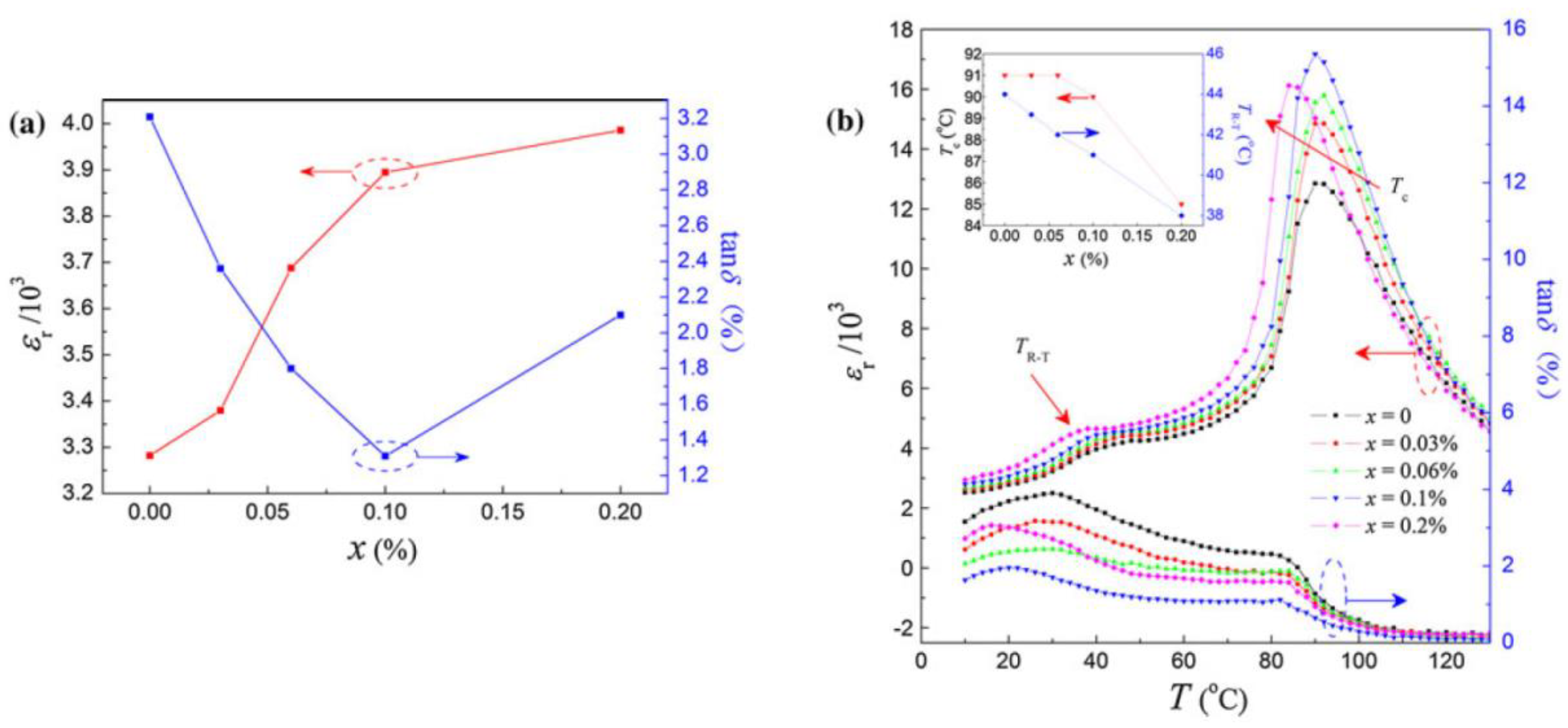
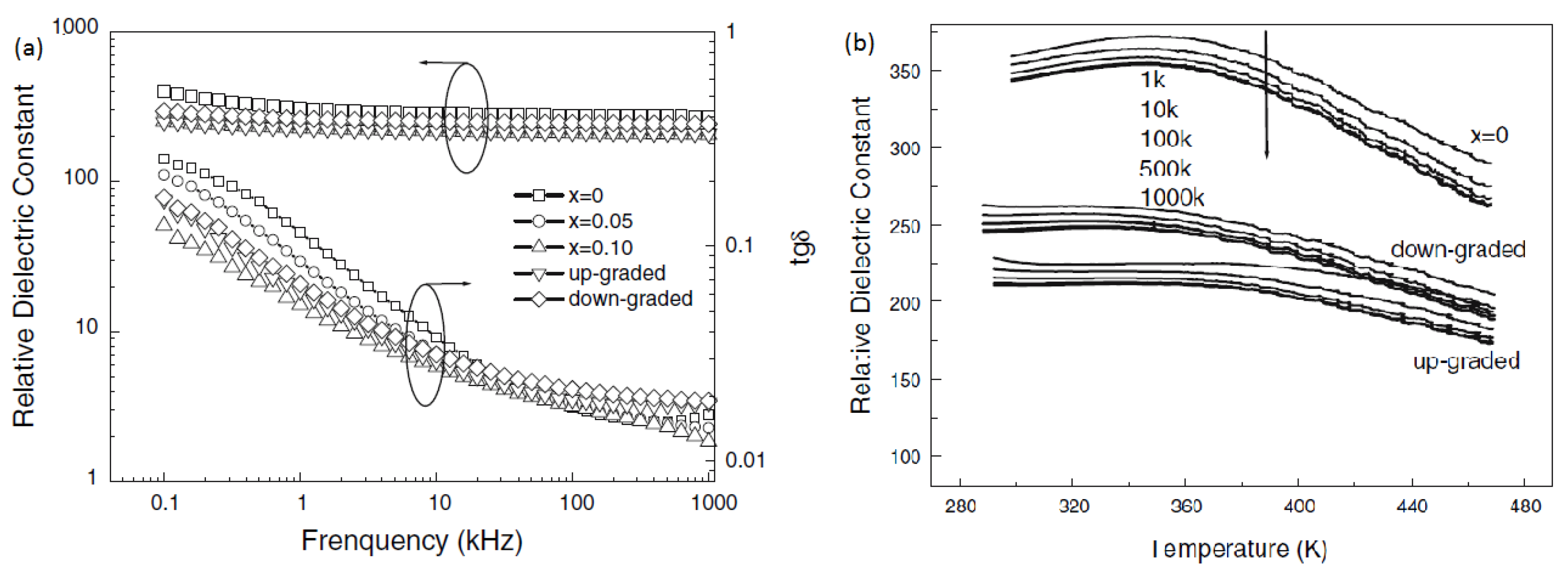
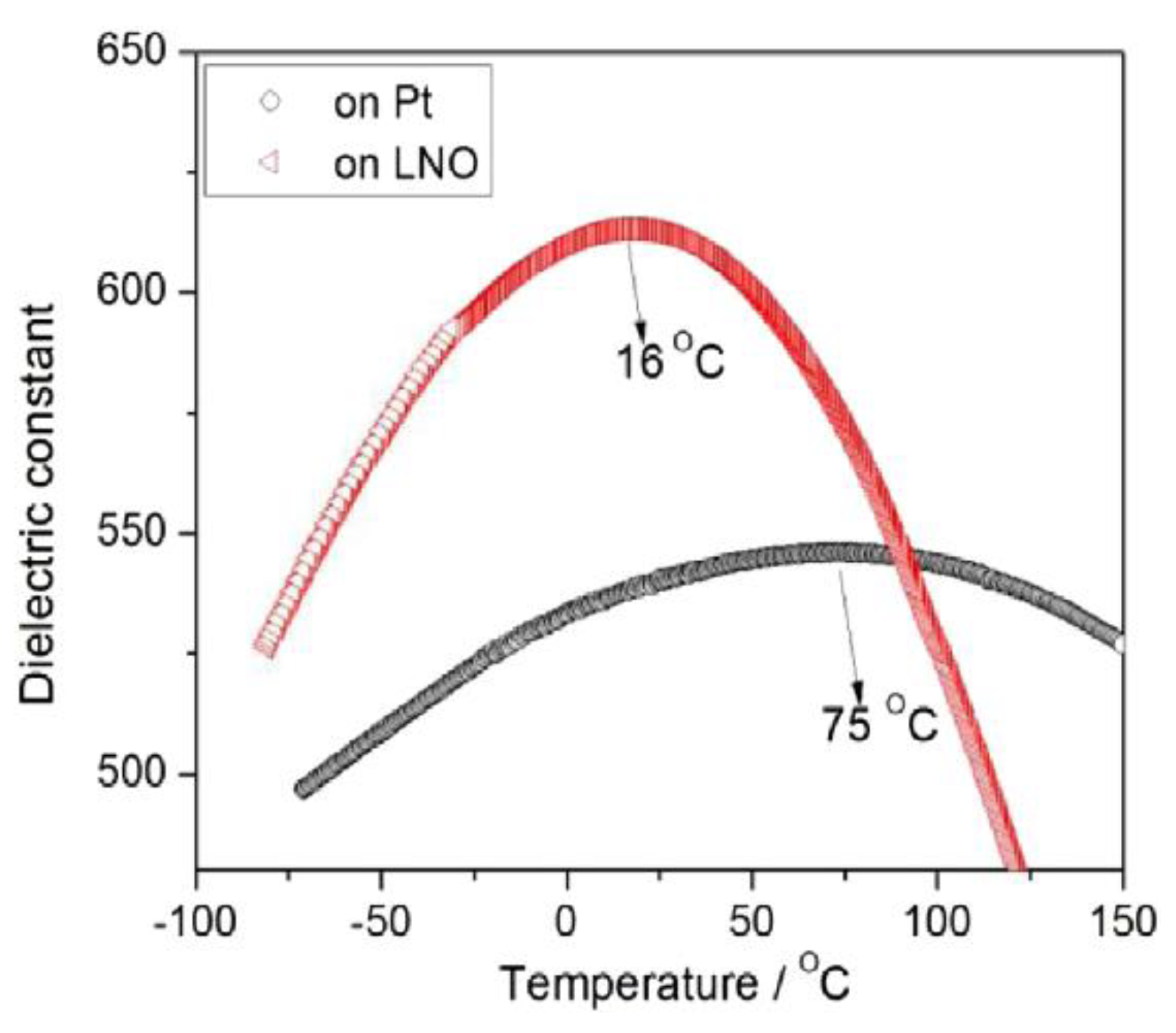
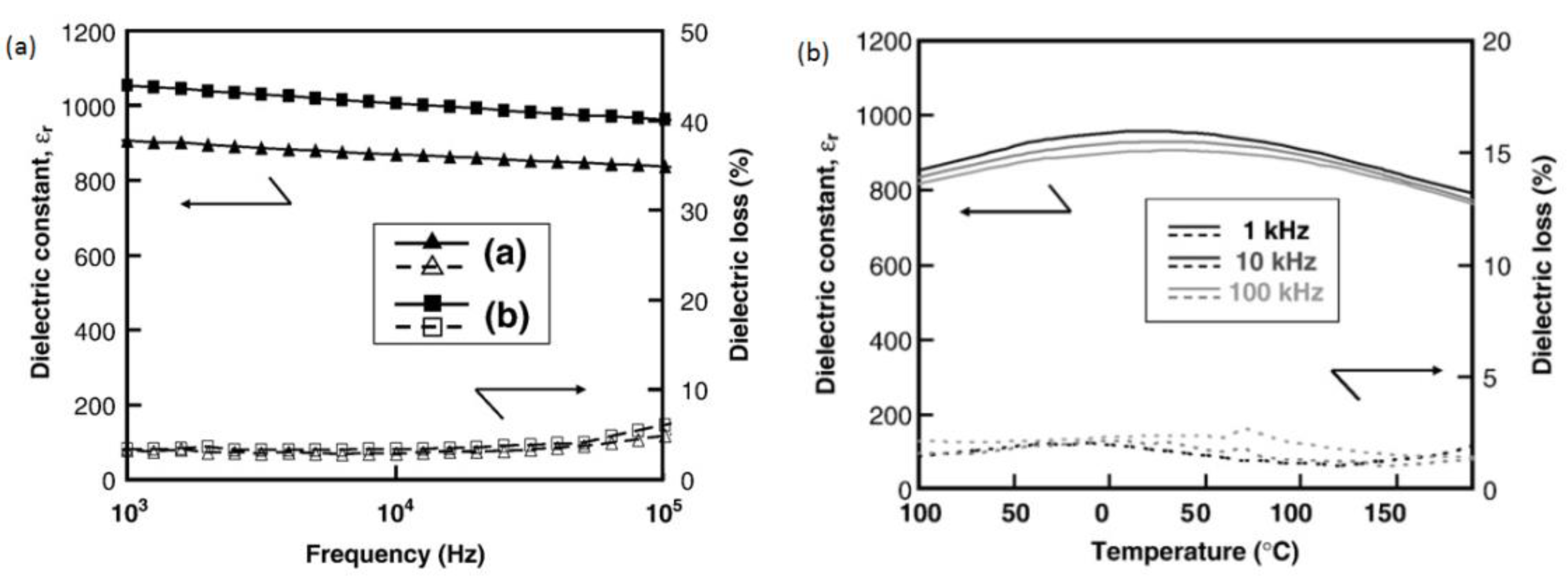

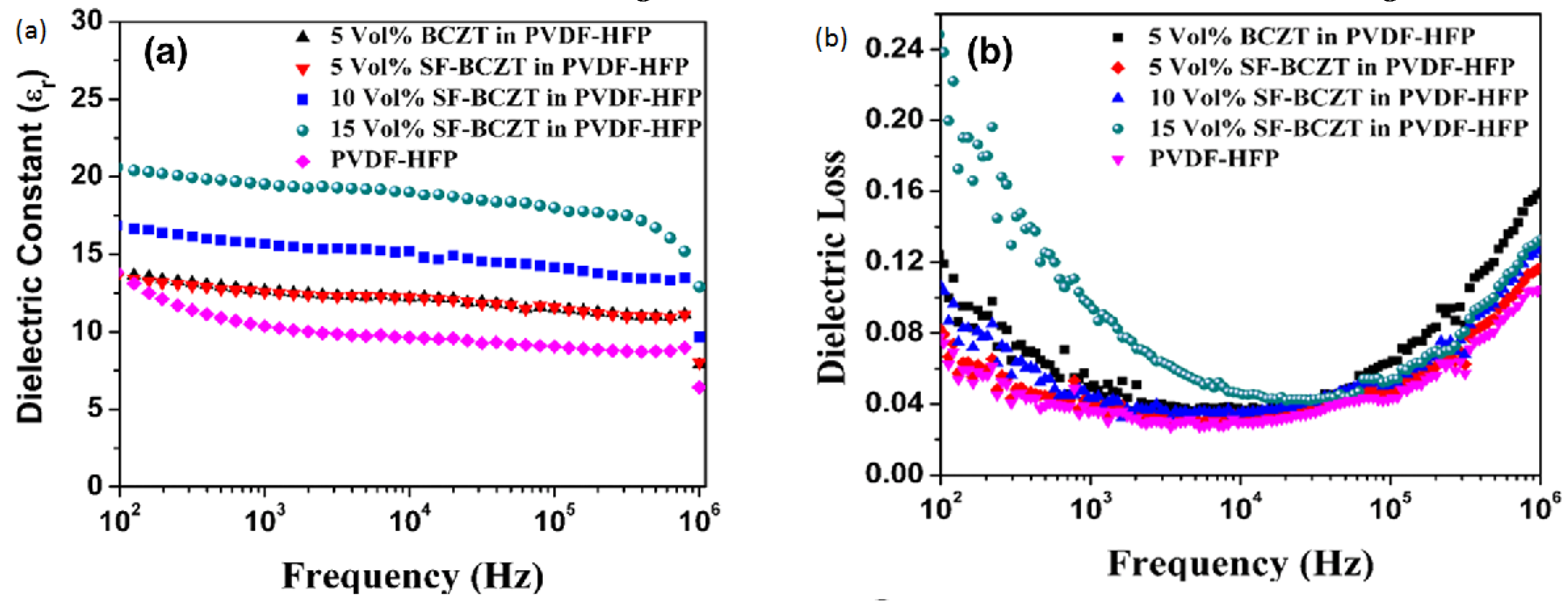
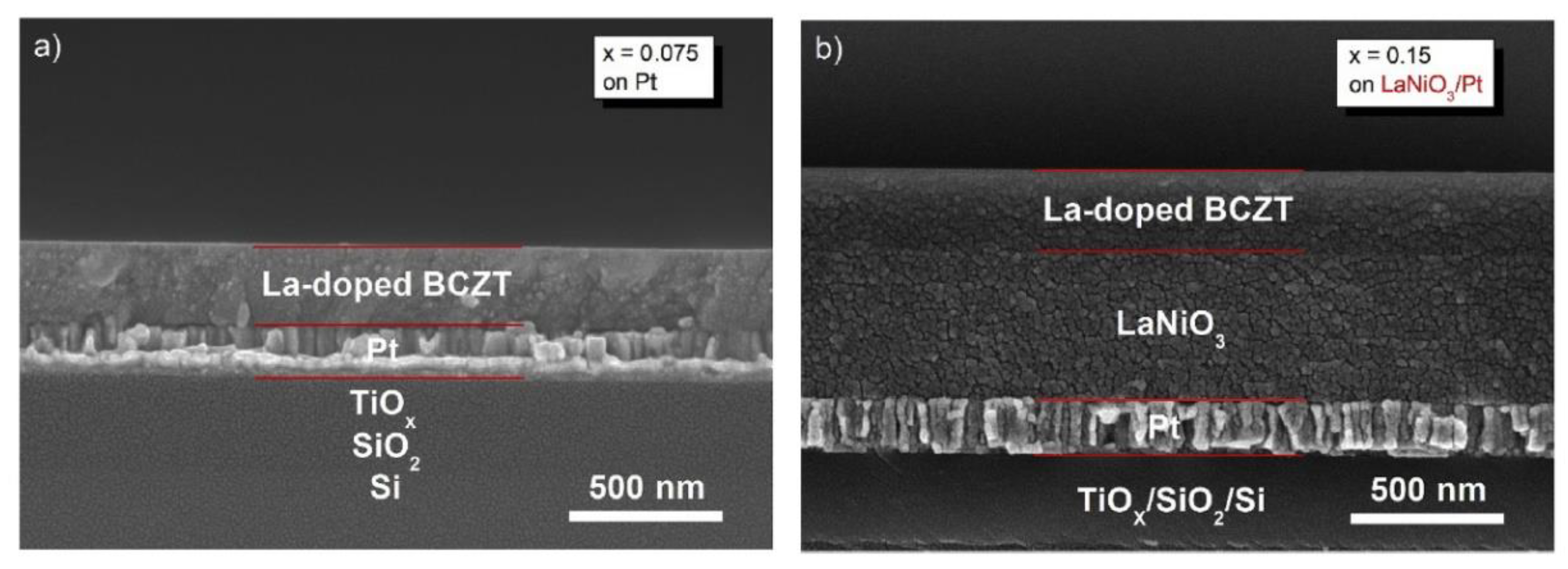
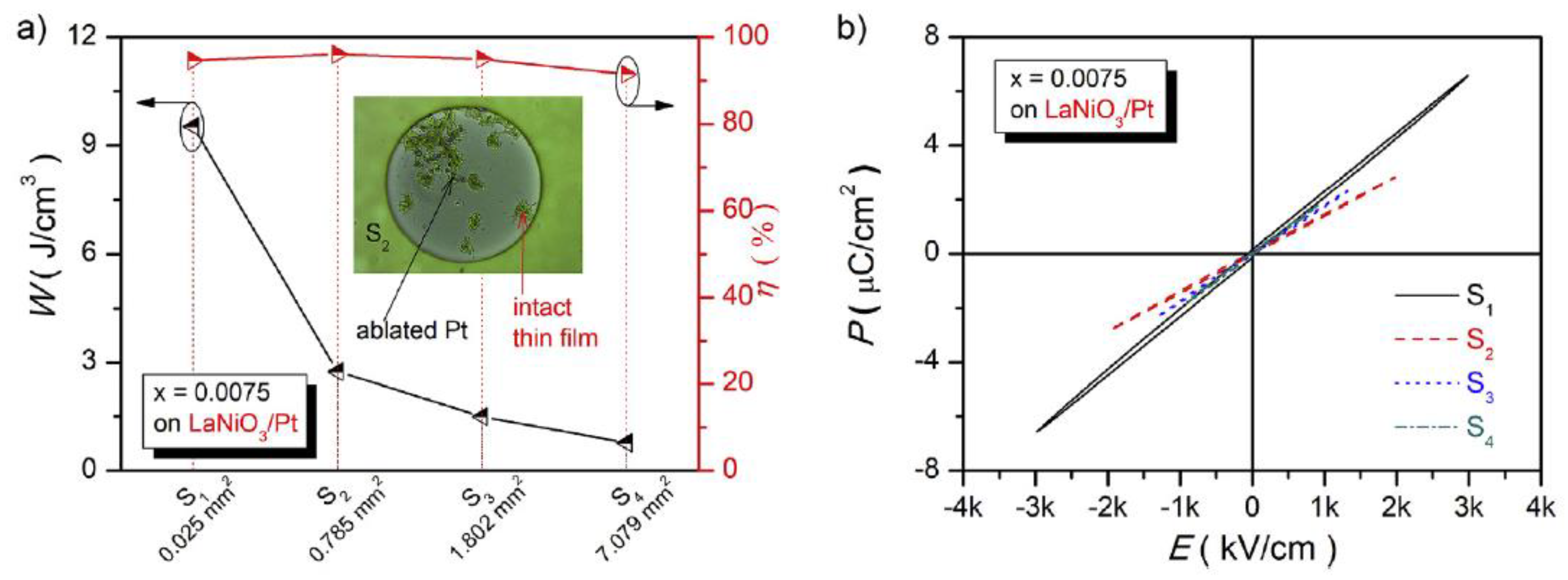
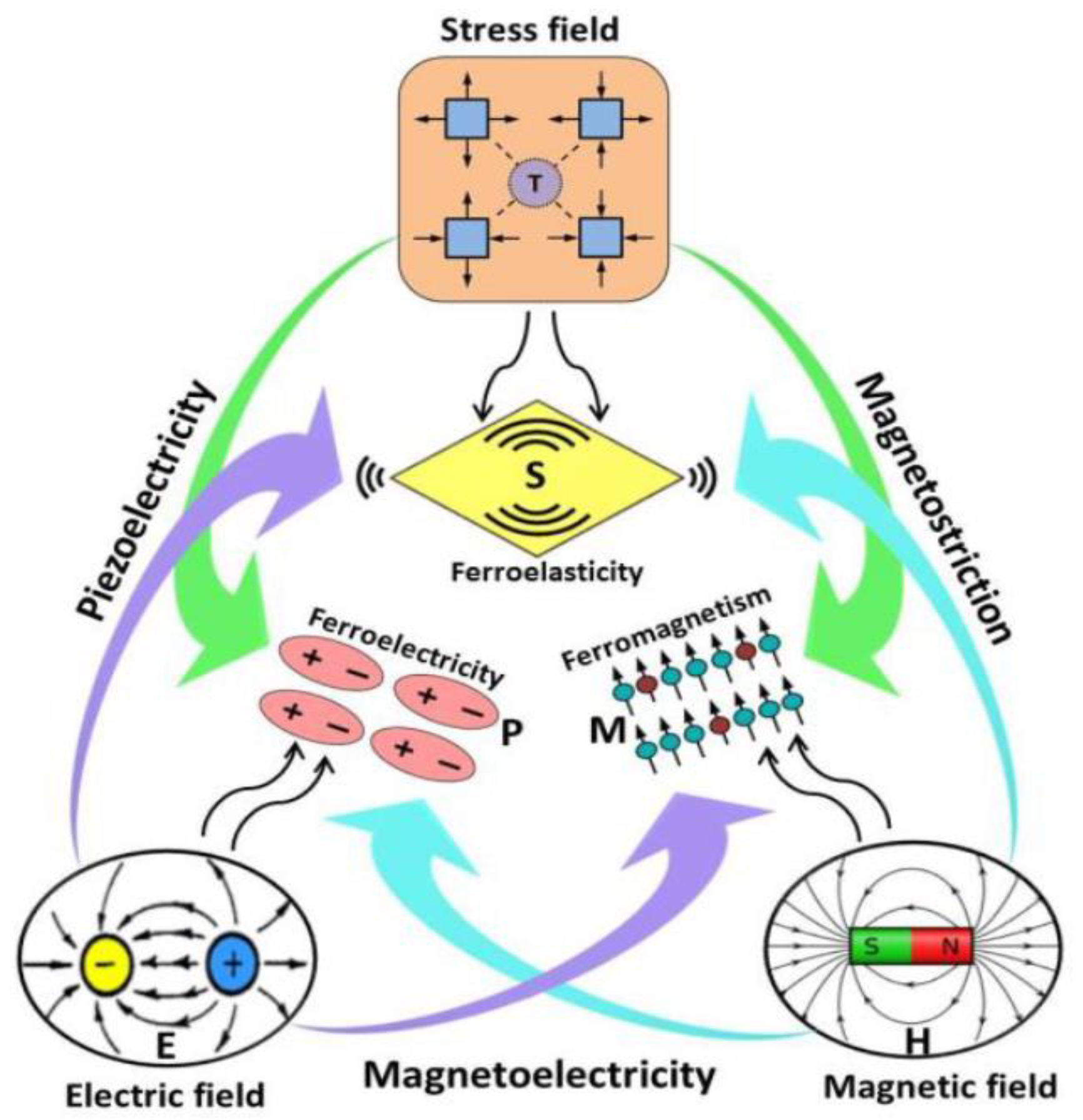
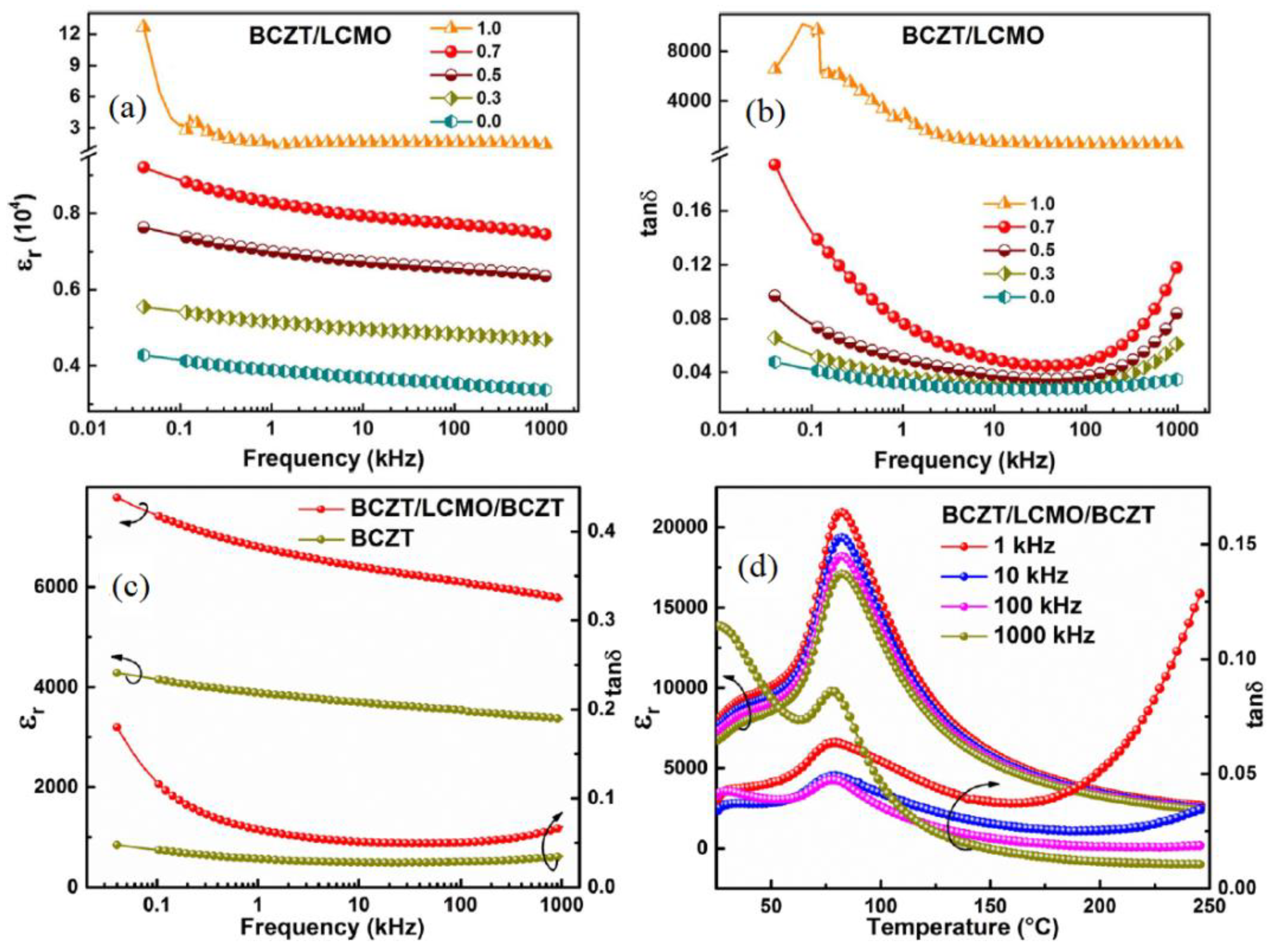
| Dopant | Content (mol%) | εr | tanδ | Ref |
|---|---|---|---|---|
| BAO | 0.8 | 3375 | 0.021 | [76] |
| CuO | 0.02–0.10 | 3450–3400 | 1.25–1.375 | [66] |
| La2O3/Y2O3 | 0–0.5 | 16,817–21,736 | 0.063–0.1062 | [29] |
| Co | 0.01–0.03 | 4567–5540 | -- | [71] |
| Fe | 0.01–0.03 | 8543–3394 | --- | [71] |
| P(VDF-TrFE) | 0–0.4 | 11.2–90.7 | 0.024 | [77] |
| Sb2O3 | 0.2 | 4958 | 1.8 | [78] |
| Sb2O3 | 0.1 | 3895 | 1.3 | [79] |
| Nb5+ | 0.0–1.0 | 2103–4636 | 0.0130–0.0326 | [80] |
| V2O5 | 0–0.50 | 2175–3104 | 0.030–0.043 | [50] |
| Nd3+ | 0–0.02 | 17,184–6095 | 0.0245–0.0119 | [81] |
| Mn | 0–2.0 | 1314–1651 | 2.40–2.99 | [52] |
| Substrate | Process | εr (pm/V) | tanδ | Frequency | Temperature | Pr | Energy Storage | DBS | Ref |
|---|---|---|---|---|---|---|---|---|---|
| Pt/Ti/SiO2/Si | Sol–gel | 50 | (0.02) | 100 kHz | 75 °C | [60] | |||
| Si | Sputter-deposited | Higher dielectric loss | 20 Hz-1 MHz | 700–900 °C | ~8 × 10−3 W-h/kg | 200 kV/cm −2 MV/cm | [88] | ||
| Al | Sol–gel | 9.6 | Lower dielectric loss | 10 KHz | 200 °C | 8.5 J cm−3 | (>300 kV mm−1) | [61] | |
| Pt(111)/Ti/SiO2/Si | Solid state reaction | 601–2347 | Increased dielectric loss | 100 to 10 KHz | 330 °C | 47–11.8 µC cm2 | 99.8 J cm−3 | [89] | |
| Pt/TiOx/SiO2/Si | Thin-film processing methods | 900 | 5% | 700 °C | [90] | ||||
| Pt/Ti/SiO2/Si substrates without CaRuO3 (CRO) buffer layer | Pulsed laser deposition (PLD) | 725 | Decrease from 0.036 | 100 Hz to 1 MHz | 2 J/cm2 | [91] | |||
| Pt/Ti/SiO2/Si substrate with CaRuO3 | Pulsed laser deposition | 877 | 0.023 | 100 Hz to 1 MHz | 2 J/cm2 | [91] | |||
| Pt/Ti/SiO2/Si | Sol–gel under three different annealing processes | Decreases slowly for 8000–60,000 Hz | Dielectric loss is smaller for higher frequencies | 10,000–60,000 Hz | 700 °C | 10.08 μC/cm2 | [93] | ||
| Pt/Ti/SiO2/Si | Sol–gel | 550 | (0.02) | 100 KHz | 75 °C | [60] | |||
| LaNiO3(LNO)/Pt/Ti/SiO2/Si substrates | Sol–gel | 620 | (0.04) | 100 KHz | 16 °C | [60] | |||
| Clean glass plates | Solution casting method | ~140 | 1.8 to 0.2 | Frequency range of 60–107 Hz | 474–497 °C | 0.206 μC/cm2 | 5.3 J/cm3 | 20–96 kV mm−1 | [98] |
| Flexible polymeric substrates STO (001) | PLD deposition process description | 2600–2700 | ~0.02 | 1 kHz to 1 MHz | [94] | ||||
| (100)-SrRuO3/SrTiO3 substrate | Pulsed laser deposition | 400 | ~0.3 | f = 1.6 kHz | At room temperature | 35.79 and 12.43 μC cm−2 | [99] | ||
| Pt/MgO | Metal organic decomposition (MOD) | 504 | <0.04 | 1 MHz | 600–900 °C | [95] | |||
| LaNiO3/Pt | Sol–gel method | _ | 0–300 °C | 15.5 J/cm3 | (>1000 kV/cm) | [62] |
| Ferroelectric Constituent | Ferromagnetic Constituent | Remnant Polarization | Dielectric Constant | Dielectric Loss | Ref. |
|---|---|---|---|---|---|
| BZT | LSM | 15.7 | 10,516 | Increase with LSM content | [130] |
| BCT-BZT | CNFO | - | 2264 | 2.58 | [129] |
| NBT | NMF | NBT | 714 | 0.03 | [118] |
| BCZT | LCMO | 9.4 | 20,280 | 0.04 | [122] |
| BTO | CFO | 4.46 | - | - | [112] |
| NBT | ZFO | Decreases at lower frequencies | Decreases at lower frequencies | [117] | |
| BTO | BTF doped with Co and Ni | Enhanced by the application of magnetic field | Enhanced by the application of magnetic field | [115] | |
| BZT-BCT | LSMO | 24 | ~16,000 | - | [125] |
| BCZT | CFO | - | ~1800 | - | [127] |
| BCZT | NFO | 8.34 | - | - | [121] |
| BCZT | CFO | ~1.4 | ~678 | 0.093 | [120] |
| BZT-BCT | LSMO | ~47 | 4900–5100 | 0.02 | [126] |
| BZT | NFO | - | ~11,000 | Increases with increasing temperature and Mw power percentages | [132] |
| BZT-BCT | CFO | - | 2489 | 0.0542 | [131] |
| BTO | CFO | - | ~3.3 × 104 | ~0.19 | [111] |
| BNT-BT | NCZF | - | Decreases with increasing frequency | Decreases with increasing frequency | [113] |
| BT | NZF | 30 | 2250 | 0.3 | [116] |
| BCZT | LCMO | 7.444 | ~ | Decreases at low frequency and increases at high frequency | [123] |
| BST | NCF | - | Dielectric constant decreases | Decreases with increasing frequency | [114] |
| BCT-BZT | LSMO | 1.57 | ~2500 | ~0.02 | [128] |
| PZT | CFO | ~540 | ~0.01 at 1 MHz | [110] |
© 2019 by the authors. Licensee MDPI, Basel, Switzerland. This article is an open access article distributed under the terms and conditions of the Creative Commons Attribution (CC BY) license (http://creativecommons.org/licenses/by/4.0/).
Share and Cite
Maraj, M.; Wei, W.; Peng, B.; Sun, W. Dielectric and Energy Storage Properties of Ba(1−x)CaxZryTi(1−y)O3 (BCZT): A Review. Materials 2019, 12, 3641. https://doi.org/10.3390/ma12213641
Maraj M, Wei W, Peng B, Sun W. Dielectric and Energy Storage Properties of Ba(1−x)CaxZryTi(1−y)O3 (BCZT): A Review. Materials. 2019; 12(21):3641. https://doi.org/10.3390/ma12213641
Chicago/Turabian StyleMaraj, Mudassar, Wenwang Wei, Biaolin Peng, and Wenhong Sun. 2019. "Dielectric and Energy Storage Properties of Ba(1−x)CaxZryTi(1−y)O3 (BCZT): A Review" Materials 12, no. 21: 3641. https://doi.org/10.3390/ma12213641
APA StyleMaraj, M., Wei, W., Peng, B., & Sun, W. (2019). Dielectric and Energy Storage Properties of Ba(1−x)CaxZryTi(1−y)O3 (BCZT): A Review. Materials, 12(21), 3641. https://doi.org/10.3390/ma12213641





